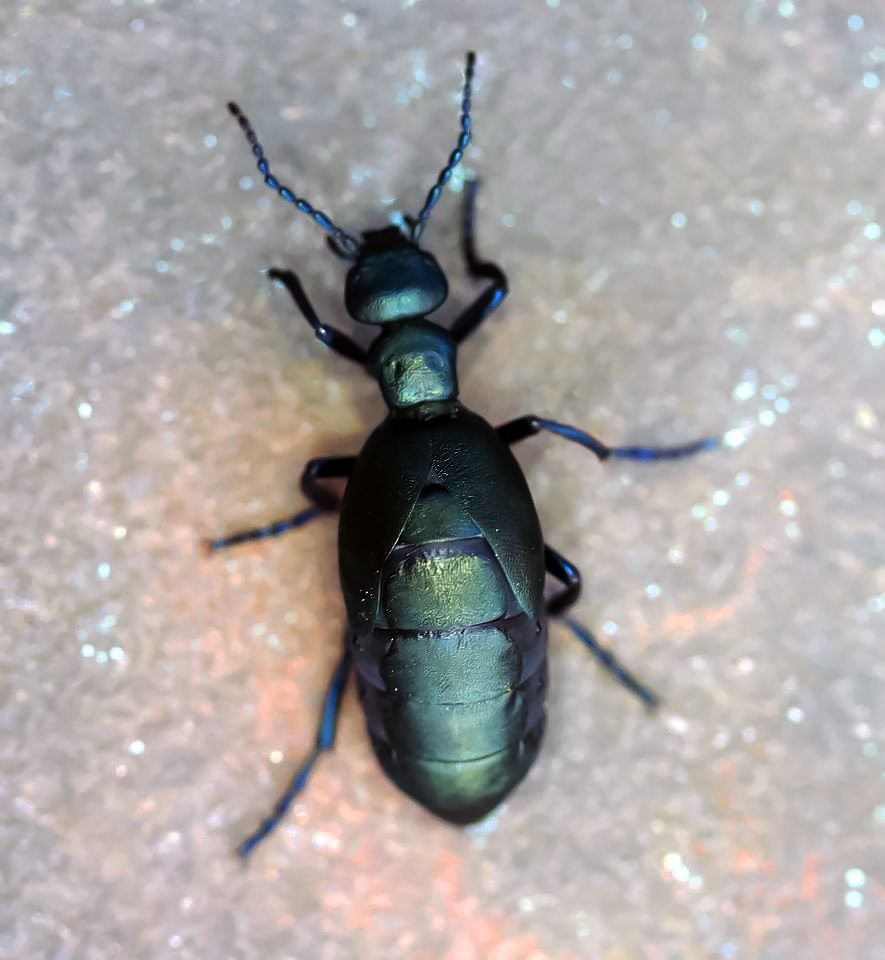|
Meloe
The blister beetle genus ''Meloe'' is a large, widespread group commonly referred to as oil beetles. They are known as "oil beetles" because they release oily droplets of hemolymph from their joints when disturbed; this contains cantharidin, a poisonous chemical causing blistering of the skin and painful swelling. Members of this genus are typically flightless, without functional wings, and shortened elytra. As in other members of the family, they are hypermetamorphic, going through several larval stages, the first of which is typically a mobile triungulin that finds and attaches to a host in order to gain access to the host's offspring. In this genus, the host is a bee Bees are winged insects closely related to wasps and ants, known for their roles in pollination and, in the case of the best-known bee species, the western honey bee, for producing honey. Bees are a monophyletic lineage within the superfamil ..., and each species of ''Meloe'' may attack only a single spec ... [...More Info...] [...Related Items...] OR: [Wikipedia] [Google] [Baidu] |
Meloe Violaceus
''Meloe violaceus'', the violet oil beetle, is a species of oil beetle belonging to the family Meloidae subfamily Meloinae. These beetles are present in most of Europe, in the eastern Palearctic realm, in the Near East, and in North Africa. This species is characterized by hypermetamorphosis, a kind of complete insect metamorphosis in which, in addition to the normal stages of larva, nymph and imago, they have several others, with great differences in appearance and way of life. The body of ''Meloe violaceus'' is long, females are somewhat larger than the males. These beetle are black-blue or violet-blue, head and pronotum are very finely dotted and the elytra are quite shorter than the abdomen, as in other Meloinae Meloinae is a subfamily of beetles in the family Meloidae. There are at least 330 described species in Meloinae. Genera * '' Cordylospasta'' Horn, 1875 * '' Cysteodemus'' LeConte, 1851 (desert spider beetles) * ''Epicauta'' Dejean, 1834 * '' Eup ... species. ... [...More Info...] [...Related Items...] OR: [Wikipedia] [Google] [Baidu] |
Meloe Franciscanus
''Meloe franciscanus'' is a species of blister beetle in the family Meloidae. It is found in the deserts of the southwestern United States. The larvae are parasites of bee larvae, eating them and consuming their provisions. Distribution and habitat ''Meloe franciscanus'' is endemic to the southwestern United States where it is found among dunes in deserts. This habitat is variable and includes patches of vegetation surrounded by barren areas of sand. One of the plants here is ''Astragalus lentiginosus'' which provides food for the adult beetles, which are flightless, and nectar for their host bees. The eggs of the beetle are typically laid at the base of the plants in these "islands" of vegetation. Ecology The larvae of this beetle successfully make use of sexual deception by mimicking the mating signals of another insect species. Adult female beetles lay eggs in a compact mass underground, with the egg aggregations on average containing 761 eggs. The beetle larvae emerge from ... [...More Info...] [...Related Items...] OR: [Wikipedia] [Google] [Baidu] |
Meloe Americanus
''Meloe americanus'', the buttercup oil beetle, is a species of blister beetle in the family Meloidae Blister beetles are beetles of the family Meloidae, so called for their defensive secretion of a blistering agent, cantharidin. About 7,500 species are known worldwide. Many are conspicuous and some are aposematically colored, announcing their .... It is found in North America. Subspecies These two subspecies belong to the species ''Meloe americanus'': * ''Meloe americanus americanus'' * ''Meloe americanus occidentalis'' Van References Further reading * * Meloidae Articles created by Qbugbot Beetles described in 1815 {{meloidae-stub ... [...More Info...] [...Related Items...] OR: [Wikipedia] [Google] [Baidu] |
Meloe Campanicollis
''Meloe campanicollis'' is a species of blister beetle in the family Meloidae Blister beetles are beetles of the family Meloidae, so called for their defensive secretion of a blistering agent, cantharidin. About 7,500 species are known worldwide. Many are conspicuous and some are aposematically colored, announcing their .... It is found in North America. References Further reading * * Meloidae Articles created by Qbugbot Beetles described in 1970 {{meloidae-stub ... [...More Info...] [...Related Items...] OR: [Wikipedia] [Google] [Baidu] |
Meloe Barbarus
''Meloe barbarus'' is a species of blister beetle in the family Meloidae Blister beetles are beetles of the family Meloidae, so called for their defensive secretion of a blistering agent, cantharidin. About 7,500 species are known worldwide. Many are conspicuous and some are aposematically colored, announcing their .... It is found in North America. References Further reading * * Meloidae Articles created by Qbugbot Beetles described in 1861 {{meloidae-stub ... [...More Info...] [...Related Items...] OR: [Wikipedia] [Google] [Baidu] |

